Toyota Prius (2004)
 | ||
 | 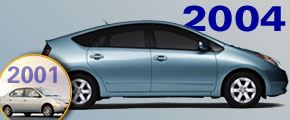 |  |
| ||||||
| Good: more powerful, roomier, improved hybrid powertrain. Bad: noisy at high speeds, safety, visibility, okay handling. |  |  |  |  | ||
Simply put, Toyota is this generation's world leader in the most significant advancement in automobiles. When Toyota launched the first hybrid Prius back in 2001, it was a breakthrough vehicle. It was an environmentally responsible car that demanded no sacrifice from its owner. Well, nothing more than the few thousand bucks extra you paid for it over a similarly sized Corolla. But it was a car that ran, in part, on batteries. Yet you didn't have to plug it in, you didn't have to limit your driving distance, and you never had to stop at the Seven-Eleven and buy them out of D-cells. You got in it, you drove it, and bada bing bada bang, you got 40-plus miles per gallon. The new, 2004 Prius simply improves on the old one. It's larger, roomier, and more powerful. Yet it retains all of the advantages —and the price—of the original.
| ||||||||
 | The hybrid gas-electric power plant is now more powerful, and you'll notice better acceleration when you drive it. The gasoline engine gained a modest six horsepower compared to the earlier Prius, while the electric motor gained a significant 23 horsepower.
We had one minor complaint with our test car: When you're stopped at a light, the engine on the Prius stops running to save fuel (that's not the complaint—that's a good thing). But when you start moving again, you'll notice a little jerk when the electric motor restarts the gasoline engine. It may have been a quirk with our test car, or it may be due to the increased power of the new electric motor (which serves as the starter motor for the gas engine). It's not a big deal, but if you do a lot of stop-and-go driving, the engine may stop and start hundreds of times in a day—all of which could make this little kick somewhat annoying. If all of the new Priuses do this, you'll have to be willing to accept it as a trade-off for the fuel you save and pollution you eliminate. The Prius isn't the kind of car you buy for handling. The handling is adequate, and is comparable to other "soft-riders" in this price range. But it's not the kind of car with which you go zooming around corners. Besides, if you drive it like a sports car, you're going to defeat the purpose of buying it—to save fuel and reduce pollution.
We are just as concerned about the safety of Prius—as we are with any small-to-normal-sized car these days. So we suggest you fork over the extra money for the side airbags. If you're going to be a good citizen and drive a car that gets 50 miles to the gallon, we want to make sure you stick around for a while. The planet needs more people like you. So get the side airbags, which will help if some moron driving an SUV, eating a hamburger, and talking on his cell phone, T-bones you. | |||||||
 |
The storage area behind the seats is pretty roomy, although the storage floor is a little higher than you might expect because Toyota used the space underneath for the battery bank. The seats fold down, which gives you pretty significant cargo space. The look of the interior is airy, spacious, and clean. | |||||||
 |
Most of the controls seemed pretty well laid out. We did find the energy monitor display increasingly annoying. At first it's fascinating to watch where the power is coming from, and when it's being regenerated by the brakes. But after a while, you cease to care. Also, right in the middle of the dashboard, there's an animation straight out of the seventh grade science curriculum that shows you what the hybrid synergy system is doing. You can set the screen to show you something else, but it defaults back to the science fair display after a few minutes. It gets old. We're told that the screen can be reprogrammed to stay on one display setting—or even to stay off. That was a relief to hear—if we drove this car for more than few weeks, we'd certainly be busy reprogramming the display.
Toyota, with its great reputation for ergonomic thoughtfulness, should have known better. | |||||||
 | The Prius doesn't draw any "oohs" and "aahs" as you pull up in front of the theatre on Saturday night. But we find the new Prius both practical and stylish—with the emphasis on practical. It also has a little bit of a futuristic, space-age quality to it with its rounded front end and aerodynamic hatchback design. One nice addition is the tiny, little triangular windows at the sides of the dashboard. They're designed to give you better visibility, and we thought they were a nice, little styling touch, too. There are similar, little windows near the back. We also liked the taillight treatment.
| |||||||
 | This version of the Prius doesn't look any more or less confusing under the hood than the original. It has the same generator and battery box. Unless you're willing to risk a 200-volt shock, we think you'll most likely have to go to the dealer for repairs on the hybrid power train. But rest assured that the other components of the car—struts, exhaust system, brake pads, or disk rotors—are all within the grasp of your neighborhood mechanic. | |||||||
 | After three or four years of experience with the Prius, we'd expect reliability to be pretty good at this point. We certainly haven't heard any major complaints from Prius owners. (For the latest news, you can always check our hybrid bulletin board). Fortunately, the warranty is very good: three years or 36,000 miles on everything; five years or 60,000 miles on the powertrain; and eight years or 100,000 miles on the hybrid-electrical components, including the expensive batteries. | |||||||
 | This car really shines in the city or suburbs. It's not an ideal highway cruiser, though you can certainly use it for that. But you'll pay a penalty in cabin noise and won't realize the fuel savings on the highway because the Prius gets its best mileage while making heavy use of the electric motor around town. There are better cars for heavy highway driving that will give you better comfort, more safety, less interior noise, and still reasonably decent mileage. But, if you're the kind of person who wants to do your part—without any heavy lifting—the Prius may be for you. It' s a no-sacrifice "green" car. And it's even got some trendy cache these days, to boot. If you want to symbolically thumb your nose at Hummers, and feel good about making a contribution to the planet, all without having to give up power, room, or convenience, check out the new Prius. But don't expect to drive off the lot with one this afternoon. In many parts of the country, there are waiting lists for the Prius. And some unscrupulous dealers (i.e., sleazeballs) are adding thousands of dollars of ADP (additional dealer profit) to the sticker—simply because they can. If you run into that, tell the dealer you'll never do business with him again, and tell all your friends. And then find someplace else to buy the car. We want to discourage this type of rip off, because this is too good a car to be held hostage to the white shoe and belt gang. | |||||||
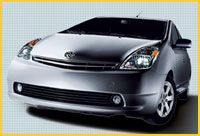 The first thing you'll notice is that the Prius has grown bigger. Once an oddly shaped, compact, four-door sedan, the Prius is now a good-looking, mid-sized, five-door lift-back. Its interior room places it about halfway between the compact Corolla and the comfortably mid-sized Camry. Drive the new Prius and you'll notice that both the
The first thing you'll notice is that the Prius has grown bigger. Once an oddly shaped, compact, four-door sedan, the Prius is now a good-looking, mid-sized, five-door lift-back. Its interior room places it about halfway between the compact Corolla and the comfortably mid-sized Camry. Drive the new Prius and you'll notice that both the 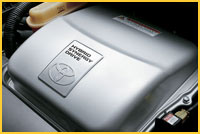 The gasoline engine is Toyota's 1.5-liter four-cylinder engine with variable valve timing, matched to a continuously variable transmission, so you'll no longer feel the transmission shifting gears.
The gasoline engine is Toyota's 1.5-liter four-cylinder engine with variable valve timing, matched to a continuously variable transmission, so you'll no longer feel the transmission shifting gears. 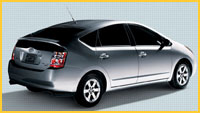 An important note: at 2,890 pounds, the Prius' weight is about average for a car of this class. But, a lot of the weight is from the bank of batteries needed to power the electric motors. So to keep the car from being a pig, Toyota had to eliminate weight elsewhere. That lighter weight may explain the extra noise we experienced at highway speed. Keep in mind, though, we drove a car that was brand-spanking-new. Add a few years of tire and wheel bearing wear, and the noise level will only increase.
An important note: at 2,890 pounds, the Prius' weight is about average for a car of this class. But, a lot of the weight is from the bank of batteries needed to power the electric motors. So to keep the car from being a pig, Toyota had to eliminate weight elsewhere. That lighter weight may explain the extra noise we experienced at highway speed. Keep in mind, though, we drove a car that was brand-spanking-new. Add a few years of tire and wheel bearing wear, and the noise level will only increase.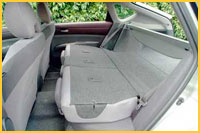
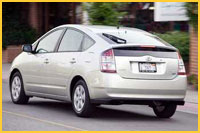 Visibility out the back isn't great. The bar that houses the rear wiper motor lies across the window at the bottom of the lift gate, and that creates a significant blind spot. You might get used to it after a while.
Visibility out the back isn't great. The bar that houses the rear wiper motor lies across the window at the bottom of the lift gate, and that creates a significant blind spot. You might get used to it after a while.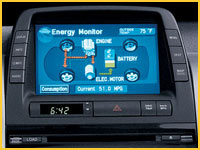 The same screen is also used to manage temperature settings, fan speeds and radio controls. We're not fans of this type of multipurpose screen, as it eliminates the nice, easy, tactile buttons that are so easy to operate—by feel—while you're driving. The screen requires you to take your eyes off the road.
The same screen is also used to manage temperature settings, fan speeds and radio controls. We're not fans of this type of multipurpose screen, as it eliminates the nice, easy, tactile buttons that are so easy to operate—by feel—while you're driving. The screen requires you to take your eyes off the road. Make no mistake—this car IS a chick magnet car—for certain types of chicks. Notably, the types who can't stand being called chicks! If you're cruising for someone in Birkenstocks and a John Kerry bumper sticker, this car may fit right into your lifestyle.
Make no mistake—this car IS a chick magnet car—for certain types of chicks. Notably, the types who can't stand being called chicks! If you're cruising for someone in Birkenstocks and a John Kerry bumper sticker, this car may fit right into your lifestyle.